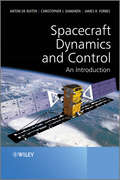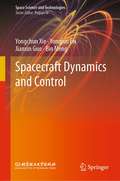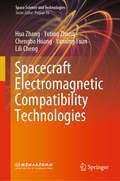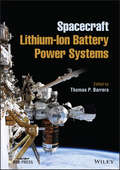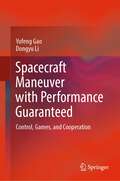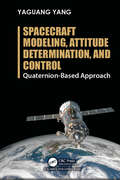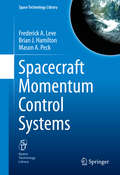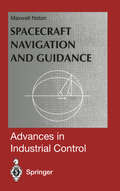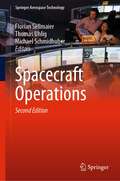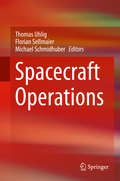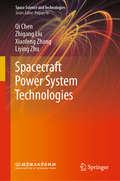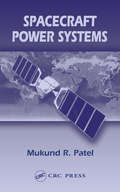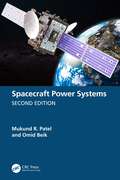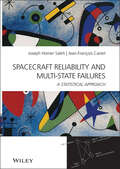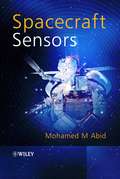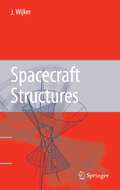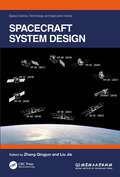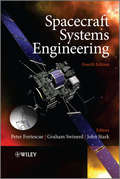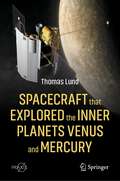- Table View
- List View
Spacecraft Dynamics and Control: An Introduction
by Anton H. de Ruiter Christopher Damaren James R. ForbesProvides the basics of spacecraft orbital dynamics plus attitude dynamics and control, using vectrix notation Spacecraft Dynamics and Control: An Introduction presents the fundamentals of classical control in the context of spacecraft attitude control. This approach is particularly beneficial for the training of students in both of the subjects of classical control as well as its application to spacecraft attitude control. By using a physical system (a spacecraft) that the reader can visualize (rather than arbitrary transfer functions), it is easier to grasp the motivation for why topics in control theory are important, as well as the theory behind them. The entire treatment of both orbital and attitude dynamics makes use of vectrix notation, which is a tool that allows the user to write down any vector equation of motion without consideration of a reference frame. This is particularly suited to the treatment of multiple reference frames. Vectrix notation also makes a very clear distinction between a physical vector and its coordinate representation in a reference frame. This is very important in spacecraft dynamics and control problems, where often multiple coordinate representations are used (in different reference frames) for the same physical vector. Provides an accessible, practical aid for teaching and self-study with a layout enabling a fundamental understanding of the subject Fills a gap in the existing literature by providing an analytical toolbox offering the reader a lasting, rigorous methodology for approaching vector mechanics, a key element vital to new graduates and practicing engineers alike Delivers an outstanding resource for aerospace engineering students, and all those involved in the technical aspects of design and engineering in the space sector Contains numerous illustrations to accompany the written text. Problems are included to apply and extend the material in each chapter Essential reading for graduate level aerospace engineering students, aerospace professionals, researchers and engineers.
Spacecraft Dynamics and Control (Space Science and Technologies)
by Yongchun Xie Yongjun Lei Jianxin Guo Bin MengThis book presents up-to-date concepts and design methods relating to space dynamics and control, including spacecraft attitude control, orbit control, and guidance, navigation, and control (GNC), summarizing the research advances in control theory and methods and engineering practice from Beijing Institute of Control Engineering over the years. The control schemes and systems based on these achievements have been successfully applied to remote sensing satellites, communication satellites, navigation satellites, new technology test satellites, Shenzhou manned spacecraft, Tianzhou freight spacecraft, Tiangong 1/2 space laboratories, Chang'e lunar explorers, and many other missions. Further, the research serves as a guide for follow-up engineering developments in manned lunar engineering, deep space exploration, and on-orbit service missions.
Spacecraft Electromagnetic Compatibility Technologies (Space Science and Technologies)
by Hua Zhang Yuting Zhang Chengbo Huang Yanxing Yuan Lili ChengThis book explores key techniques and methods in electromagnetic compatibility management, analysis, design, improvement and test verification for spacecraft. The first part introduces the general EMC technology of spacecraft, the electromagnetic interference control method and management of electromagnetic compatibility. The second part discusses the EMC prediction analysis technique and its application in spacecraft, while the third presents the EMC design of spacecraft modules and typical equipment. The final two parts address spacecraft magnetic design testing technologies and spacecraft testing technologies. The book also covers the program control test process, the special power control unit (PCU), electric propulsion, PIM test and multipaction testing for spacecraft, making it a valuable resource for researchers and engineers alike.
Spacecraft Lithium-Ion Battery Power Systems (IEEE Press)
by Thomas P. BarreraSpacecraft Lithium-Ion Battery Power Systems Provides Readers with a Better Understanding of the Requirements, Design, Test, and Safety Engineering of Spacecraft Lithium-ion Battery Power Systems Written by highly experienced spacecraft engineers and scientists working at the forefront of the aerospace industry, Spacecraft Lithium-Ion Battery Power Systems is one of the first books to provide a comprehensive treatment of the broad area of spacecraft lithium-ion battery (LIB) power systems technology. The work emphasizes the technical aspects across the entire lifecycle of spacecraft LIBs including the requirements, design, manufacturing, testing, and safety engineering principles needed to deploy a reliable spacecraft LIB-based electrical power system. A special focus on rechargeable LIB technologies as they apply to unmanned and crewed Earth-orbiting satellites, planetary mission spacecraft (such as orbiters, landers, rovers and probes), launch vehicle, and astronaut spacesuit applications is emphasized. Using a system’s engineering approach, the book bridges knowledge gaps that typically exist between academic and industry practitioners. Key topics of discussion and learning resources include: Detailed systematic technical treatment of spacecraft LIB-based electrical power systems across the entire LIB lifecycle Principles of lithium-ion cell and battery design and test, LIB sizing, battery management systems, electrical power systems, safety engineering, ground and launch-site processing, and on-orbit mission operations Special topics such as requirements engineering, qualification testing, thermal runaway hazards, dead bus events, life cycle testing and prediction analyses, on-orbit LIB power system management, and spacecraft EPS passivation strategies Comprehensive discussion of on-orbit and emerging space applications of LIBs supporting various commercial, civil, and government spacecraft missions such as International Space Station, Galileo, James Webb Telescope, Mars 2020 Perseverance Rover, Europa Clipper, Cubesats, and more Overall, the work provides professionals supporting all aspects of the aerospace marketplace with key knowledge and highly actionable information pertaining to LIBs and their specific applications in modern spacecraft systems.
Spacecraft Lithium-Ion Battery Power Systems (IEEE Press)
by Thomas P. BarreraSpacecraft Lithium-Ion Battery Power Systems Provides Readers with a Better Understanding of the Requirements, Design, Test, and Safety Engineering of Spacecraft Lithium-ion Battery Power Systems Written by highly experienced spacecraft engineers and scientists working at the forefront of the aerospace industry, Spacecraft Lithium-Ion Battery Power Systems is one of the first books to provide a comprehensive treatment of the broad area of spacecraft lithium-ion battery (LIB) power systems technology. The work emphasizes the technical aspects across the entire lifecycle of spacecraft LIBs including the requirements, design, manufacturing, testing, and safety engineering principles needed to deploy a reliable spacecraft LIB-based electrical power system. A special focus on rechargeable LIB technologies as they apply to unmanned and crewed Earth-orbiting satellites, planetary mission spacecraft (such as orbiters, landers, rovers and probes), launch vehicle, and astronaut spacesuit applications is emphasized. Using a system’s engineering approach, the book bridges knowledge gaps that typically exist between academic and industry practitioners. Key topics of discussion and learning resources include: Detailed systematic technical treatment of spacecraft LIB-based electrical power systems across the entire LIB lifecycle Principles of lithium-ion cell and battery design and test, LIB sizing, battery management systems, electrical power systems, safety engineering, ground and launch-site processing, and on-orbit mission operations Special topics such as requirements engineering, qualification testing, thermal runaway hazards, dead bus events, life cycle testing and prediction analyses, on-orbit LIB power system management, and spacecraft EPS passivation strategies Comprehensive discussion of on-orbit and emerging space applications of LIBs supporting various commercial, civil, and government spacecraft missions such as International Space Station, Galileo, James Webb Telescope, Mars 2020 Perseverance Rover, Europa Clipper, Cubesats, and more Overall, the work provides professionals supporting all aspects of the aerospace marketplace with key knowledge and highly actionable information pertaining to LIBs and their specific applications in modern spacecraft systems.
Spacecraft Maneuver with Performance Guaranteed: Control, Games, and Cooperation
by Yufeng Gao Dongyu LiFacing future-oriented aerospace applications, large-scale space construction and on-orbit services have rapidly developed. In such emerging and increasingly complex spacecraft maneuvering and control tasks, more precise control accuracy and higher performance guarantees need to be fully considered due to the need for safe close rendezvous movements.This book is dedicated to solving the aerospace system’s performance guaranteed and precise control challenges with the expected transient and strict steady-state constraints. It is designed so that the aerospace closed-loop system can theoretically meet the pre-defined or prescribed performance requirements with the simple parameter selection. Furthermore, the expected performance constraints or indicators of the aerospace system time-domain performance response, such as settling time, overshoot, steady-state error, and state amplitude, will be directly guaranteed in the control design. Moreover, this book systematically proposes a series of spacecraft performance guaranteed control algorithms based on the practical situation of the aerospace system. For individual spacecraft, control algorithms that consider practical problems such as control task requirements, settling time constraints, transient performance normalization, input command constraints, and optimization faced by the on-orbit spacecraft are proposed to achieve the precise control objectives of the system under constraints and various complex situations. For the pre-combination and post-combination control of multiple spacecraft, game algorithms based on performance guarantees are proposed and thoroughly discussed. For spacecraft formations, control algorithms that consider full-state constraints, nonlinear uncertainties, output feedback, and collision avoidance are proposed.This book provides the theoretical basis and simulation experience for scholars and engineers to develop high-performance, high-precision spacecraft control algorithms. Furthermore, it hopes that these will contribute to the development of the world’s aerospace technology.
Spacecraft Modeling, Attitude Determination, and Control: Quaternion-Based Approach
by Yaguang YangThis book discusses all spacecraft attitude control-related topics: spacecraft (including attitude measurements, actuator, and disturbance torques), modeling, spacecraft attitude determination and estimation, and spacecraft attitude controls. Unlike other books addressing these topics, this book focuses on quaternion-based methods because of its many merits. The book lays a brief, but necessary background on rotation sequence representations and frequently used reference frames that form the foundation of spacecraft attitude description. It then discusses the fundamentals of attitude determination using vector measurements, various efficient (including very recently developed) attitude determination algorithms, and the instruments and methods of popular vector measurements. With available attitude measurements, attitude control designs for inertial point and nadir pointing are presented in terms of required torques which are independent of actuators in use. Given the required control torques, some actuators are not able to generate the accurate control torques, therefore, spacecraft attitude control design methods with achievable torques for these actuators (for example, magnetic torque bars and control moment gyros) are provided. Some rigorous controllability results are provided. The book also includes attitude control in some special maneuvers, such as orbital-raising, docking and rendezvous, that are normally not discussed in similar books. Almost all design methods are based on state-spaced modern control approaches, such as linear quadratic optimal control, robust pole assignment control, model predictive control, and gain scheduling control. Applications of these methods to spacecraft attitude control problems are provided. Appendices are provided for readers who are not familiar with these topics.
Spacecraft Modeling, Attitude Determination, and Control: Quaternion-Based Approach
by Yaguang YangThis book discusses all spacecraft attitude control-related topics: spacecraft (including attitude measurements, actuator, and disturbance torques), modeling, spacecraft attitude determination and estimation, and spacecraft attitude controls. Unlike other books addressing these topics, this book focuses on quaternion-based methods because of its many merits. The book lays a brief, but necessary background on rotation sequence representations and frequently used reference frames that form the foundation of spacecraft attitude description. It then discusses the fundamentals of attitude determination using vector measurements, various efficient (including very recently developed) attitude determination algorithms, and the instruments and methods of popular vector measurements. With available attitude measurements, attitude control designs for inertial point and nadir pointing are presented in terms of required torques which are independent of actuators in use. Given the required control torques, some actuators are not able to generate the accurate control torques, therefore, spacecraft attitude control design methods with achievable torques for these actuators (for example, magnetic torque bars and control moment gyros) are provided. Some rigorous controllability results are provided. The book also includes attitude control in some special maneuvers, such as orbital-raising, docking and rendezvous, that are normally not discussed in similar books. Almost all design methods are based on state-spaced modern control approaches, such as linear quadratic optimal control, robust pole assignment control, model predictive control, and gain scheduling control. Applications of these methods to spacecraft attitude control problems are provided. Appendices are provided for readers who are not familiar with these topics.
Spacecraft Momentum Control Systems: A Comprehensive Guide (Space Technology Library #1010)
by Frederick A. Leve Brian J. Hamilton Mason A. PeckThe goal of this book is to serve both as a practical technical reference and a resource for gaining a fuller understanding of the state of the art of spacecraft momentum control systems, specifically looking at control moment gyroscopes (CMGs). As a result, the subject matter includes theory, technology, and systems engineering. The authors combine material on system-level architecture of spacecraft that feature momentum-control systems with material about the momentum-control hardware and software. This also encompasses material on the theoretical and algorithmic approaches to the control of space vehicles with CMGs. In essence, CMGs are the attitude-control actuators that make contemporary highly agile spacecraft possible. The rise of commercial Earth imaging, the advances in privately built spacecraft (including small satellites), and the growing popularity of the subject matter in academic circles over the past decade argues that now is the time for an in-depth treatment of the topic. CMGs are augmented by reaction wheels and related algorithms for steering all such actuators, which together comprise the field of spacecraft momentum control systems. The material is presented at a level suitable for practicing engineers and those with an undergraduate degree in mechanical, electrical, and/or aerospace engineering.
Spacecraft Navigation and Guidance (Advances in Industrial Control)
by Maxwell NotonThe analysis and computational techniques associated with the navigation and guidance of spacecraft are now in a mature state of development. However the documentation has remained dispersed throughout conference papers, journals, company and contract rep orts, making it difficult to get a true, comprehensive picture of the subject. This text brings together the body of literature with suitable attention to the necessary underlying mathematics and computational techniques. It covers in detail the necessary orbital mechanics, orbit determination with emphasis on the SRIF algorithm, gr avity assist manoeuvres and guidance, both ground-based and autonomous. Attention is paid to all phases of a space mission including launch and re-entry, and whether culminating in an earth satellite or a deep space mission to planets or primitive bodies. Software associated with the text is available free to the reader by means of the Internet server of the publisher. 'Spacecraft Navigation and Guidance' is an invaluable aid for all those working within astronautics, aeronautics, and control engineering in general.
Spacecraft Operations (Springer Aerospace Technology)
by Florian Sellmaier Thomas Uhlig Michael SchmidhuberThis book describes the basic concepts of spacecraft operations for both manned and unmanned missions. The first part of the book provides a brief overview of the space segment. The next four parts deal with the classic areas of space flight operations: mission operations, communications and infrastructure, the flight dynamics system, and the mission planning system. This is followed by a part describing the operational tasks of the various subsystems of a classical satellite in Earth orbit. The last part describes the special requirements of other mission types due to the presence of astronauts, the approach of a satellite to another target satellite, or leaving Earth orbit in interplanetary missions and landing on other planets and moons.The 2nd edition is published seven years after the first edition. It contains four new chapters on flight procedures, the human factors, ground station operation, and software and systems. In addition, several chapters have been extensively expanded. The entire book has been brought up to date and the language has been revised.This book is based on the “Spacecraft Operations Course” held at the German Space Operations Center. However, the target audience of this book is not only the participants of the course, but also students of technical and scientific courses, as well as technically interested people who want to gain a deeper understanding of spacecraft operations.
Spacecraft Operations
by Thomas Uhlig Florian Sellmaier Michael SchmidhuberThe book describes the basic concepts of spaceflight operations, for both, human and unmanned missions. The basic subsystems of a space vehicle are explained in dedicated chapters, the relationship of spacecraft design and the very unique space environment are laid out. Flight dynamics are taught as well as ground segment requirements. Mission operations are divided into preparation including management aspects, execution and planning. Deep space missions and space robotic operations are included as special cases. The book is based on a course held at the German Space Operation Center (GSOC).
Spacecraft Power System Technologies (Space Science and Technologies)
by Qi Chen Zhigang Liu Xiaofeng Zhang Liying ZhuThis book provides an introduction to the main design principles, methods, procedures, and development trends in spacecraft power systems. It is divided into nine chapters, the first of which covers the classification and main components of primary power system design and power distribution system design. In turn, Chapters 2 to 4 focus on the spacecraft power system design experience and review the latest typical design cases concerning spacecraft power systems in China. More specifically, these chapters also introduce readers to the topological structure and key technologies used in spacecraft power systems. Chapters 5 to 7 address power system reliability and safety design, risk analysis and control, and in-orbit management in China’s spacecraft engineering projects. The book’s closing chapters provide essential information on new power systems and technologies, such as space nuclear power, micro- and nano-satellite power systems, and space energy interconnection systems. An outlook on future development trends rounds out the coverage.
Spacecraft Power Systems
by Mukund R. PatelThe power systems of space vehicles have undergone significant development during the previous decade, and will continue to do so in the immediate future. Until now, except for the scattered results of conferences and a few publications with sketchy coverage, no single volume has covered the entire spectrum of the subject. Spacecraft Power
Spacecraft Power Systems
by Mukund R. Patel Omid BeikThis second edition of Spacecraft Power Systems is a comprehensive coverage of the fundamentals, design trades, components, controls, and operations of spacecraft power systems based on the real-world design and operations of spacecraft that have successfully flown for decades. It also includes emerging high-voltage, high-power systems for in-space propulsion for interplanetary travel. With new and updated chapters, sections, and discussions, the second edition covers up-to-date high-voltage, MW-scale electric propulsion, updated PV and battery systems, spacecraft power components, power electronics, and their architectures and operations. This book also presents the latest in spacecraft design processes and trades, controls, operations, and protection. This book is intended for senior undergraduate and graduate students in mechanical, aerospace, and electrical engineering taking courses in Space Systems, Space Engineering, and Spacecraft Power Systems, as well as for practicing aerospace and power engineers and managers who are designing, developing, and operating spacecraft power systems.
Spacecraft Power Systems
by Mukund R. Patel Omid BeikThis second edition of Spacecraft Power Systems is a comprehensive coverage of the fundamentals, design trades, components, controls, and operations of spacecraft power systems based on the real-world design and operations of spacecraft that have successfully flown for decades. It also includes emerging high-voltage, high-power systems for in-space propulsion for interplanetary travel. With new and updated chapters, sections, and discussions, the second edition covers up-to-date high-voltage, MW-scale electric propulsion, updated PV and battery systems, spacecraft power components, power electronics, and their architectures and operations. This book also presents the latest in spacecraft design processes and trades, controls, operations, and protection. This book is intended for senior undergraduate and graduate students in mechanical, aerospace, and electrical engineering taking courses in Space Systems, Space Engineering, and Spacecraft Power Systems, as well as for practicing aerospace and power engineers and managers who are designing, developing, and operating spacecraft power systems.
Spacecraft Reliability and Multi-State Failures: A Statistical Approach
by Joseph Homer Saleh Jean-François CastetThe aerospace community has long recognized and repeatedly emphasizes the importance of reliability for space systems. Despite this, little has been published in book form on the topic. Spacecraft Reliability and Multi-state Failures addresses this gap in the literature, offering a unique focus on spacecraft reliability based on extensive statistical analysis of system and subsystem anomalies and failures. The authors provide new results pertaining to spacecraft reliability based on extensive statistical analysis of on-orbit anomaly and failure data that will be particularly useful to spacecraft manufacturers and designers, for example in guiding satellite (and subsystem) test and screening programs and providing an empirical basis for subsystem redundancy and reliability growth plans. The authors develop nonparametric results and parametric models of spacecraft and spacecraft subsystem reliability and multi-state failures, quantify the relative contribution of each subsystem to the failure of the satellites thus identifying the subsystems that drive spacecraft unreliability, and propose advanced stochastic modeling and analysis tools for the reliability and survivability of spacecraft and space-based networks. Spacecraft Reliability and Multi-state Failures provides new nonparametric results pertaining to spacecraft reliability based on extensive statistical analysis of on-orbit anomaly and failure data; develops parametric models of spacecraft and spacecraft subsystem reliability and multi-state failures quantifies the relative contribution of each subsystem to the failure of the satellites proposes advanced stochastic modeling and analysis tools for the reliability and survivability of spacecraft and space-based networks. provides a dedicated treatment of the reliability and subsystem anomalies of communication spacecraft in geostationary orbit.
Spacecraft Reliability and Multi-State Failures: A Statistical Approach
by Joseph Homer Saleh Jean-François CastetThe aerospace community has long recognized and repeatedly emphasizes the importance of reliability for space systems. Despite this, little has been published in book form on the topic. Spacecraft Reliability and Multi-state Failures addresses this gap in the literature, offering a unique focus on spacecraft reliability based on extensive statistical analysis of system and subsystem anomalies and failures. The authors provide new results pertaining to spacecraft reliability based on extensive statistical analysis of on-orbit anomaly and failure data that will be particularly useful to spacecraft manufacturers and designers, for example in guiding satellite (and subsystem) test and screening programs and providing an empirical basis for subsystem redundancy and reliability growth plans. The authors develop nonparametric results and parametric models of spacecraft and spacecraft subsystem reliability and multi-state failures, quantify the relative contribution of each subsystem to the failure of the satellites thus identifying the subsystems that drive spacecraft unreliability, and propose advanced stochastic modeling and analysis tools for the reliability and survivability of spacecraft and space-based networks. Spacecraft Reliability and Multi-state Failures provides new nonparametric results pertaining to spacecraft reliability based on extensive statistical analysis of on-orbit anomaly and failure data; develops parametric models of spacecraft and spacecraft subsystem reliability and multi-state failures quantifies the relative contribution of each subsystem to the failure of the satellites proposes advanced stochastic modeling and analysis tools for the reliability and survivability of spacecraft and space-based networks. provides a dedicated treatment of the reliability and subsystem anomalies of communication spacecraft in geostationary orbit.
Spacecraft Sensors
by Mohamed M. AbidSpacecraft Sensors, the first of its kind, offers a comprehensive review of many aspects and intricacies of sensors used in the spacecraft industry. It covers sensor development from concept, design, and cost, to building, testing, interfacing, integrating, and on-orbit operation. It is intended for the specialist or non-specialist engineer, scientist, and those involved in the business aspect of the spacecraft industry. Focusing on how these various disciplines contribute to the development of a sensor used in space, this key text: Explains how mathematics, physics, business, and engineering-based concepts are used to develop and design a sensor which complies with a set of specific requirements. Discusses essential topics such as cost estimation, signal processing, noise reduction, filters, phased arrays, radars, optics, and radiometers used in space operation. Covers a range of typical sensors used in the spacecraft industry such as infrared, passive microwave, radars and spacebased GPS sensors. Concludes each chapter with examples of past and current orbiting sensors such as DSP, SBIRS, CHAMP, LANDSAT, and GOES to illustrate how concepts are applied. Includes the Matlab codes used to create the example plots in order to give the reader a starting point for further analysis Spacecraft Sensors is an invaluable resource for engineers, technical consultants, those in the business division, and research scientists associated with spacecraft projects. It is also an excellent textbook for undergraduate and postgraduate students studying the development, design and applications of spacebased sensors.
Spacecraft Structures
by J. Jaap WijkerSpace flight is a comprehensive and innovative part of technology. It encompasses many fields of technology. This monograph presents a cross section of the total field of expertise that is called "space flight". It provides an optimal reference with insight into the design, construction and analysis aspects of spacecraft. The emphasis of this book is put on unmanned space flight, particularly on the construction of spacecraft rather than the construction of launch vehicles.
Spacecraft System Design (Space Science, Technology and Application Series)
by Liu JieDrawing on practical engineering experience and latest achievements of space technology in China, this title investigates spacecraft system design and introduces several design methods based on the model development process.A well-established space engineering system with spacecraft as the core is integral to spaceflight activities and missions of entering, exploring, developing and utilizing outer space. This book expounds the key phases in the workflow of spacecraft development, including task analysis, overall plan design, external interface, configuration and assembly design and experimental verification. Subsystems that function as the nuclei of spacecraft design and important aspects in the model development process are then examined, such as orbit design, environmental influence factors, reliability design, dynamics analysis, etc. In addition, it also discusses the digital environment and methods to improve the efficiency of system design.The title will appeal to researchers, students, and especially professionals interested in spacecraft system design and space engineering.
Spacecraft System Design (Space Science, Technology and Application Series)
Drawing on practical engineering experience and latest achievements of space technology in China, this title investigates spacecraft system design and introduces several design methods based on the model development process.A well-established space engineering system with spacecraft as the core is integral to spaceflight activities and missions of entering, exploring, developing and utilizing outer space. This book expounds the key phases in the workflow of spacecraft development, including task analysis, overall plan design, external interface, configuration and assembly design and experimental verification. Subsystems that function as the nuclei of spacecraft design and important aspects in the model development process are then examined, such as orbit design, environmental influence factors, reliability design, dynamics analysis, etc. In addition, it also discusses the digital environment and methods to improve the efficiency of system design.The title will appeal to researchers, students, and especially professionals interested in spacecraft system design and space engineering.
Spacecraft Systems Engineering (Aerospace Ser.)
by Peter Fortescue Graham Swinerd John StarkThis fourth edition of the bestselling Spacecraft Systems Engineering title provides the reader with comprehensive coverage of the design of spacecraft and the implementation of space missions, across a wide spectrum of space applications and space science. The text has been thoroughly revised and updated, with each chapter authored by a recognized expert in the field. Three chapters – Ground Segment, Product Assurance and Spacecraft System Engineering – have been rewritten, and the topic of Assembly, Integration and Verification has been introduced as a new chapter, filling a gap in previous editions. This edition addresses ‘front-end system-level issues’ such as environment, mission analysis and system engineering, but also progresses to a detailed examination of subsystem elements which represents the core of spacecraft design. This includes mechanical, electrical and thermal aspects, as well as propulsion and control. This quantitative treatment is supplemented by an emphasis on the interactions between elements, which deeply influences the process of spacecraft design. Adopted on courses worldwide, Spacecraft Systems Engineering is already widely respected by students, researchers and practising engineers in the space engineering sector. It provides a valuable resource for practitioners in a wide spectrum of disciplines, including system and subsystem engineers, spacecraft equipment designers, spacecraft operators, space scientists and those involved in related sectors such as space insurance. In summary, this is an outstanding resource for aerospace engineering students, and all those involved in the technical aspects of design and engineering in the space sector.
Spacecraft Systems Engineering (Aerospace Series)
by Peter Fortescue Graham Swinerd John StarkThis fourth edition of the bestselling Spacecraft Systems Engineering title provides the reader with comprehensive coverage of the design of spacecraft and the implementation of space missions, across a wide spectrum of space applications and space science. The text has been thoroughly revised and updated, with each chapter authored by a recognized expert in the field. Three chapters – Ground Segment, Product Assurance and Spacecraft System Engineering – have been rewritten, and the topic of Assembly, Integration and Verification has been introduced as a new chapter, filling a gap in previous editions. This edition addresses ‘front-end system-level issues’ such as environment, mission analysis and system engineering, but also progresses to a detailed examination of subsystem elements which represents the core of spacecraft design. This includes mechanical, electrical and thermal aspects, as well as propulsion and control. This quantitative treatment is supplemented by an emphasis on the interactions between elements, which deeply influences the process of spacecraft design. Adopted on courses worldwide, Spacecraft Systems Engineering is already widely respected by students, researchers and practising engineers in the space engineering sector. It provides a valuable resource for practitioners in a wide spectrum of disciplines, including system and subsystem engineers, spacecraft equipment designers, spacecraft operators, space scientists and those involved in related sectors such as space insurance. In summary, this is an outstanding resource for aerospace engineering students, and all those involved in the technical aspects of design and engineering in the space sector.
Spacecraft that Explored the Inner Planets Venus and Mercury (Springer Praxis Books)
by Thomas LundA series of increasingly capable spacecraft were sent to explore the inner planets Venus and Mercury. The history of that planetary exploration is traced in this book along with the evolution of sophisticated spacecraft that unveiled long-sought secrets of the planets. The spacecraft were ingenious and reflected the best efforts of talented people working with the available technology of the day. Additionally, this book showcases engineering involved in those capable machines. A consecutive series of 34 planetary spacecraft, which span the time period 1961 to 2021, are described. This includes the unsuccessful missions of several early spacecraft that paved the way for a better understanding of Venus’ hostile environments. This book will describe many successful spacecraft sent to Venus by the Soviet Union and many successful spacecraft sent to Venus and to Mercury by the United States.The recent exploration of Venus by the European Space Agency’s Venus Express and the Japanese spacecraft Akatsuki can also be found in this book. The author draws on over 50 years of experience on aircraft and spacecraft systems to tell the story of these planetary spacecraft. The spacecraft experience includes being the technical lead for the landing radars on the Surveyor and Apollo lunar landers as well as providing analyses for the rendezvous radar for the Space Shuttle. Practical engineering experience is augmented by Master’s degrees in electrical engineering, physics, and business administration.
